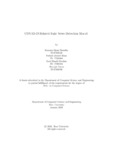| dc.contributor.advisor | Parvez, Mohammad Zavid | |
| dc.contributor.advisor | Kabir, Ashad | |
| dc.contributor.advisor | Akhond, Mostafijur Rahman | |
| dc.contributor.author | Shondhy, Sumaiya Islam | |
| dc.contributor.author | Khan, Forhad Ahmed | |
| dc.contributor.author | Ibrahim, Syed Shoaib | |
| dc.contributor.author | Barua, Shuvajit | |
| dc.date.accessioned | 2021-10-19T06:07:51Z | |
| dc.date.available | 2021-10-19T06:07:51Z | |
| dc.date.copyright | 2021 | |
| dc.date.issued | 2021-01 | |
| dc.identifier.other | ID 17101532 | |
| dc.identifier.other | ID 17301083 | |
| dc.identifier.other | ID 17301144 | |
| dc.identifier.other | ID 17301168 | |
| dc.identifier.uri | http://hdl.handle.net/10361/15432 | |
| dc.description | This thesis is submitted in partial fulfillment of the requirements for the degree of Bachelor of Science in Computer Science and Engineering, 2021. | en_US |
| dc.description | Cataloged from PDF version of thesis. | |
| dc.description | Includes bibliographical references (pages 55-56). | |
| dc.description.abstract | In this era of developed information and technology, any sort of information runs
faster than air. The reliability of the information can be tricky at times. Some
news publishing sources can publish news that are actually misguiding. The drastic
evolution of electronic media over the past couple of decades has fueled the spread
of fake news causing confusion and misunderstanding among the mass regarding
any topic. The main motive behind producing these fake news is to create an
agenda or to spread trepidation among people. People tend to become more panicked
during any kind of disaster or pandemic, this it is easier to make them believe these
misinformation in these times. Likewise, COVID-19 pandemic is not out of the
grasp of misinformation spreading. To tackle this, we have proposed a Fake News
Prediction model that will be used to detect fake news regarding COVID-19 that
are being circulated in different electronic media. | en_US |
| dc.description.statementofresponsibility | Sumaiya Islam Shondhy | |
| dc.description.statementofresponsibility | Forhad Ahmed Khan | |
| dc.description.statementofresponsibility | Syed Shoaib Ibrahim | |
| dc.description.statementofresponsibility | Shuvajit Barua | |
| dc.format.extent | 56 pages | |
| dc.language.iso | en | en_US |
| dc.publisher | Brac University | en_US |
| dc.rights | Brac University theses are protected by copyright. They may be viewed from this source for any purpose, but reproduction or distribution in any format is prohibited without written permission. | |
| dc.subject | COVID-19 | en_US |
| dc.subject | Fake news detection | en_US |
| dc.subject | Dataset | en_US |
| dc.subject | news article | en_US |
| dc.subject.lcsh | COVID-19 (Disease) | |
| dc.title | COVID-19 related fake news detection model | en_US |
| dc.type | Thesis | en_US |
| dc.contributor.department | Department of Computer Science and Engineering, Brac University | |
| dc.description.degree | B. Computer Science | |

